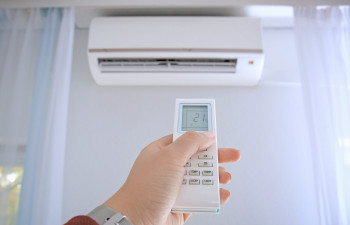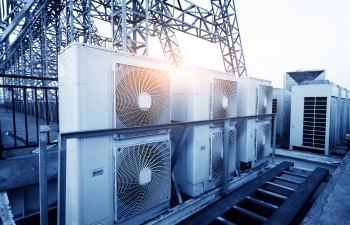The Heating, Ventilating and Air Conditioning (HVAC) industry is packed full of acronyms and terminology, that can often feel quite alien to those without formal training. Two terms you will regularly come across are comfort cooling and process cooling. Both have very different aims and applications, which means it’s vital to understand how the cooling systems work, to choose the correct technology for your project.
What is comfort cooling?
To most end users, the term comfort cooling is synonymous with the term air conditioning. Commonly used in offices and residential properties, these systems are designed to provide cooling to create a comfortable indoor climate. Comfort cooling systems are designed to offset lower density heat loads (e.g. heat generated by people, electronics, lighting etc.) and are typically used when buildings are occupied. Temperature control is on-demand but seasonal, usually on hot days when the inside temperature becomes unpleasant.
Comfort cooling systems focus primarily on making the indoor environment comfortable for humans to live and work, hence their popularity in offices and domestic properties. However, they are not designed for all year round operation, which can lead to reliability issues if systems are in use 24/7.
Comfort cooling system types
Comfort cooling can be used in a wide range of applications and building types, from single rooms, to vast spaces such as exhibition halls. Systems come in a number of configurations and technology options, with some allowing for additional functionality such as heating, humidity control, air purification or ventilation.
From budget to high-end options, system types can include:
- Self-contained portable air conditioning units for temporary use
- Split systems where one indoor and one outdoor unit provide comfort cooling (or heating) for one room
- Multi-split systems where multiple indoor units (up to around 10) are connected to one outdoor unit
- Packaged systems that provide an all-in-one solution to deliver cooled or heated air
- Variable Refrigerant Flow (VRF) systems, similar to muti-split systems, that can also allow for internal heat recovery
- Large packaged systems to provide chilled air in an air distribution system, for non-domestic buildings
- Chiller systems for large residential and non-domestic buildings.
Whatever system you choose, comfort cooling is ideal for on demand, seasonal cooling to keep indoor environments comfortable for occupants.
What is process cooling?
Process cooling is widely used in larger industrial applications to remove excess heat from a particular process, or to cool large indoor spaces such as a factory floor in a food processing plant. The systems are designed to offset higher density heat loads (e.g. heat from industrial processes) and work constantly to deliver precise temperature control.
Process cooling systems are engineered to operate 24 hours a day, 365 days a year and are designed for reliability. Industrial process cooling applications can include data centres, manufacturing, food and drink production, laboratories, indoor agriculture, hospitals and airports.
Many industries require the removal of unwanted heat, whether that is to make a manufacturing process faster and more efficient, enhance the quality of a product, ensure technology operates at its optimum level, or simply ensure safe operation of machinery in production lines.
Examples include:
- Direct cooling of machinery to ensure it works effectively, safely and to minimise wear and tear
- Direct cooling of a product in the course of the manufacturing process e.g. during plastic mould injection, solidification times can be reduced using process cooling, which in turn speeds up production significantly
- To cool an area e.g. ensure optimum temperatures for food processing, indoor agriculture, printing, alcohol fermentation or leisure facilities such as ice rinks
- To cool medical equipment such as MRI machines to ensure they deliver optimum performance.
Process cooling system types
Process cooling systems normally utilise chiller units because they excel at delivering the constant and precise temperature control required. Systems typically utilise air-cooled or water-cooled chillers, with different configurations and technologies available.
Air-cooled chillers
Air-cooled chillers are more commonly found in small to medium sized applications. The chiller units use ambient air to release heat so are best suited to locations with consistent ambient temperatures. Air-cooled chillers are less complex systems to design, install and maintain compared to their water-cooled counterparts. This also makes them cheaper to install, although they do have higher running costs. They often use less space and are predominantly installed outside.
Water-cooled chillers
Water-cooled chillers are often found in medium to large applications. The system uses water as the medium to release heat, and will require a separate cooling tower, along with associated pipework, pumps and tanks. Water-cooled systems are therefore more complex to design, install and maintain, but are usually much more energy efficient than air-cooled chillers. In general they have longer lifespan as they are typically housed indoors away from the elements. These systems will require water treatment to prevent the formation of bacteria such as legionella or mineral deposits in the system.
Chiller systems are versatile and can be used for both process cooling and comfort cooling applications.
Choosing your cooling products – the benefits of certification
While choice can be a great thing, when you have to decide on the cooling system to use in your next project, it’s vital you make the right decision. Not only will it ensure the system performs as required and that you hit all relevant codes and standards, but with fluctuating fuel prices, it’s never been more important to ensure you chose an energy efficient unit.
When product performance is not certified, making the right choice becomes difficult. Certification enables you to compare products objectively to make an informed decision. Benefits of choosing a certified product include:
- The product performance is evaluated according to the same criteria, and the results are expressed in the same unit of measurement, regardless of the country where the products are manufactured or marketed
- A certified product has its performance verified by an impartial, independent and competent accredited body
- Certified products comply with standards
- A product whose performance is certified will work according to the specifications stated by the manufacturer.
So if you want to view and compare certified products such as chillers, a good place to start is our certified product directory. The easy to use search facility lets you view products by family, type, brand, model name and certificate number.
Search for certified products now






